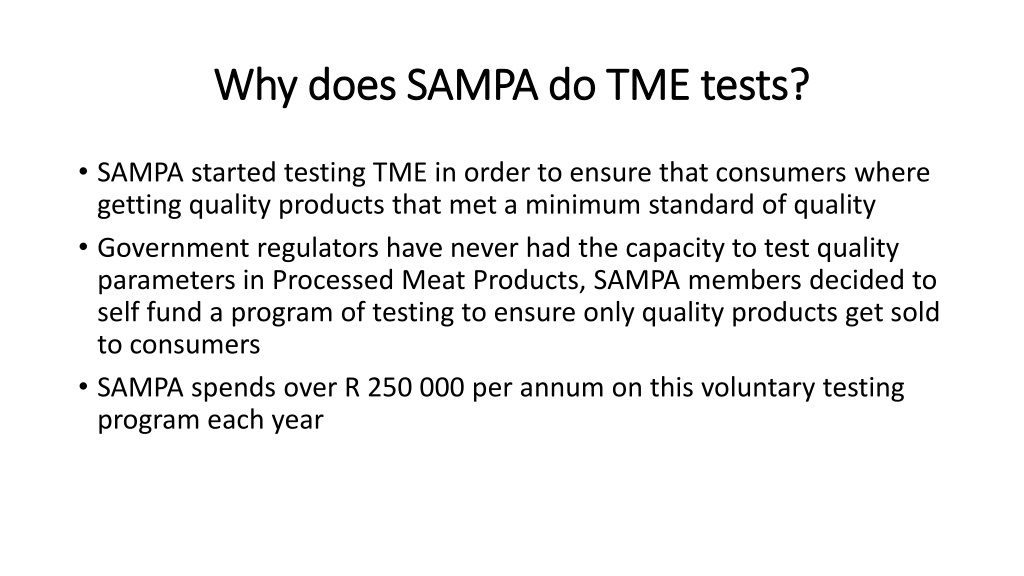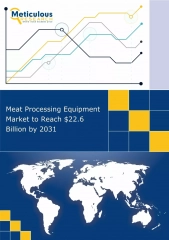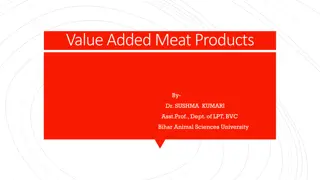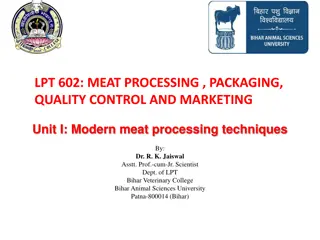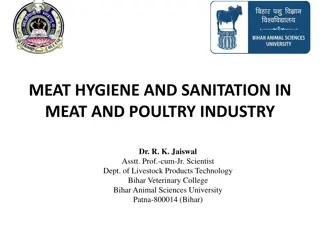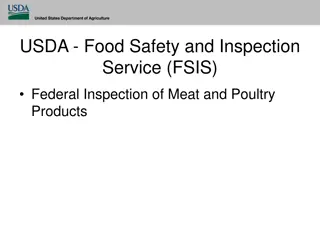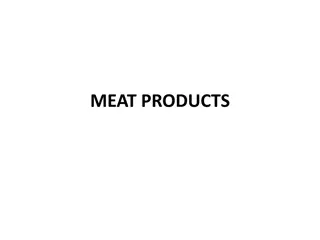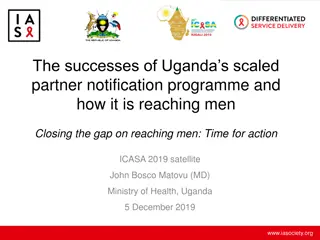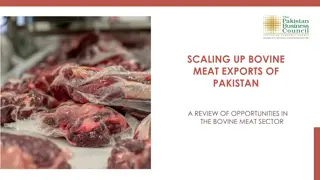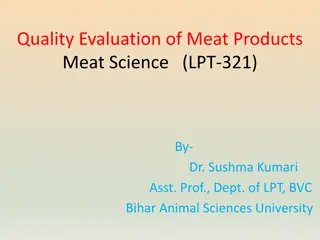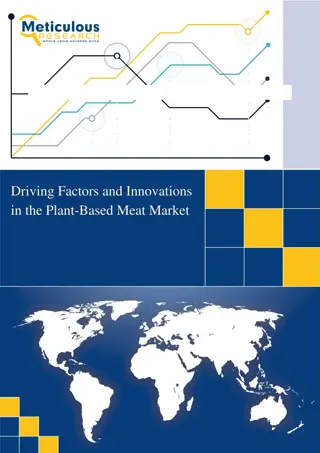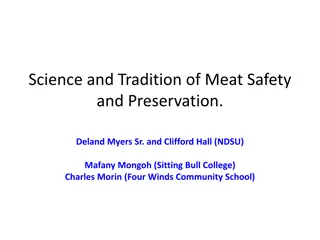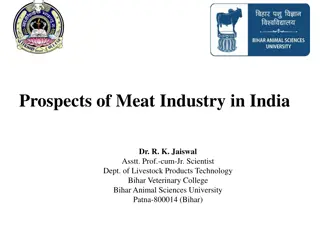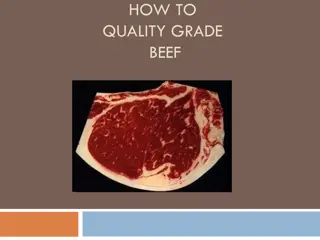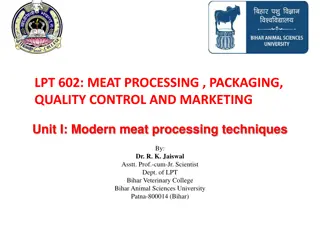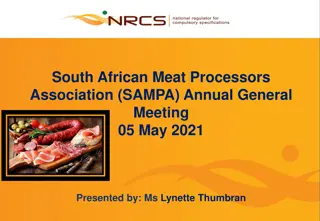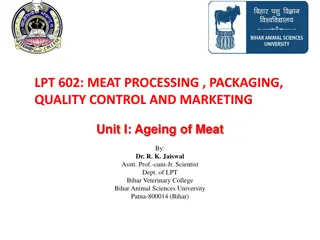SAMPA's TME Testing Program for Quality Meat Products
SAMPA conducts TME tests to ensure consumers receive quality processed meat products that meet minimum standards of quality. The Total Meat Equivalent (TME) is a measure of product quality defined in SANS 885. Testing is done by Food Consulting Services using NIR technology. SAMPA decides what products to test based on a rolling 12-month schedule and deals with non-compliant products directly.
Download Presentation

Please find below an Image/Link to download the presentation.
The content on the website is provided AS IS for your information and personal use only. It may not be sold, licensed, or shared on other websites without obtaining consent from the author.If you encounter any issues during the download, it is possible that the publisher has removed the file from their server.
You are allowed to download the files provided on this website for personal or commercial use, subject to the condition that they are used lawfully. All files are the property of their respective owners.
The content on the website is provided AS IS for your information and personal use only. It may not be sold, licensed, or shared on other websites without obtaining consent from the author.
E N D
Presentation Transcript
Why does SAMPA do TME tests? Why does SAMPA do TME tests? SAMPA started testing TME in order to ensure that consumers where getting quality products that met a minimum standard of quality Government regulators have never had the capacity to test quality parameters in Processed Meat Products, SAMPA members decided to self fund a program of testing to ensure only quality products get sold to consumers SAMPA spends over R 250 000 per annum on this voluntary testing program each year
What is TME and why 60% ? What is TME and why 60% ? Total Meat Equivalent is a measure of product quality and the minimum TME % is defined in SANS 885 Where do I find the regulation? SANS 885: 2011 Edition 3 page 27 Table 2 Class 6 6.1 , 6.2, 6.3 refers Total Meat Equivalent Minimum Percentage= 60 Table 2 Class 7 - Total Meat Equivalent Minimum Percentage= 60
Who does the TME testing and how? Who does the TME testing and how? Testing is conducted by Food Consulting Services at their Johannesburg laboratories FCS is an independent company , who collect samples countrywide and do TME testing on behalf of SAMPA each month FCS use SAMPA s Perten 7250 Near-infrared Spectroscopy (NIR)machine click on link below to see a video of how the Perten works https://youtu.be/d2kOn-_2ZTQ NIR technology for routine analysis of food and agricultural products. Near Infrared (NIR) analysis is a spectroscopic technique that makes use of the naturally occurring electromagnetic spectrum. The NIR region is the area of the spectrum defined by wavelengths between 700nm and 2500nm.
How does SAMPA decide what products to test How does SAMPA decide what products to test and when? and when? SAMPA provides a sampling schedule to FCS our partners, which covers all provinces on a rolling 12 months schedule Product and brands are randomly chosen based on their regional and national footprint , including Private Label brands Results are confidential and detailed results will not be shared with the industry Products that are found to be below the required minimum as per SANS 885 will be dealt with directly by the SAMPA CEO and vendor concerned Non Compliant products are retested within 30 days of the failed test to ensure compliance
How to read the TME graphs How to read the TME graphs Planned Tests = the total number of samples SAMPA has asked to be tested Actual Tested = the total available samples of the planned product range, available when the FCS team drew samples ( FCS cannot go back to a store repeatedly, therefore a 100% of the samples are not always available on the day) Passed = TME > 60% Failed = TME < 60 %
SAMPA Total Meat Equivalent Tests SAMPA Total Meat Equivalent Tests TME Test results for June 2019 30 25 20 15 10 5 0 Gauteng Limpopo Free State Western Cape Eastern Cape Kzn Total Planned Tests Actual Tested Passed Failed
SAMPA Total Meat Equivalent Tests SAMPA Total Meat Equivalent Tests TME Test results for July 2019 45 40 35 30 25 20 15 10 5 0 Gauteng Limpopo Free State Western Cape Eastern Cape Kzn Total Planned tests Actual Tested Passed Failed
SAMPA Total Meat Equivalent Tests SAMPA Total Meat Equivalent Tests TME Test results for August 2019 50 45 40 35 30 25 20 15 10 5 0 Gauteng Limpopo Free State Western Cape Eastern Cape Kzn Total Planned Tests Actual Tested Passed Failed
SAMPA Total Meat Equivalent Tests SAMPA Total Meat Equivalent Tests TME Test results for September 2019 35 30 25 20 15 10 5 0 Gauteng Limpopo Free State Western Cape Eastern Cape Kzn Total Planned Tests Actual Tested Passed Failed
